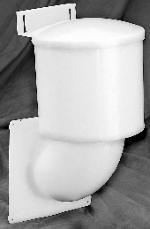Search engine visitors - click here to access entire "$ensible Home" web site
Click here to see a descriptive illustration of several dryer vent kits and pest repellers.
Dear Jim: I just noticed when I was outdoors that my dryer vent flapper does not seal well. Are there any high-quality, yet inexpensive ones that seal better? Can I direct the dryer air indoors to save the heat? - Pat B.

A: It is very important to install a tight-sealing dryer vent cover for several reasons. The dryer vent duct is a direct open path from indoors to outdoors. If the vent cover does not seal well, it is just like leaving a window partially open. This drives up your utility bills year-round.
Other less obvious problems are insects, mice, etc. that enter your comfy, warm home through the vent. If you ever wondered how mosquitoes get into your house during the summer, a leaky dryer vent cover may be the source. It may also be a source of pollen and mold spores that aggravate allergies.
Kits are available with lint traps for venting an electric dryer indoors in the winter to save the heat and humidity (check your local codes about this). NEVER vent a gas dryer indoors. The dryer stays attached to the outdoor vent, so you just flip a lever to switch from outdoors to indoors.
One of the best-sealing dryer vent kits is a floating cap design. I use one at my own home. It is made of durable plastic, so your children will have a difficult time breaking it. You can paint it to match your house or just keep its natural beige color. It extends out only about seven inches.
When you turn your dryer on, the pressure from the exhaust air flow lifts a lightweight plastic sealing cap inside of the unit. It continues to float until the dryer stops and then the cap settles back down. All of the internal parts are made of very smooth plastic to minimize lint buildup.
Another good option is a draft sealer kit that mounts inside the house where the vent pipe comes in from outdoors. In that location, the sealing flap is less prone to damage and degradation from the sun and bad weather.
When using one of these, you can cover the outdoor vent with a pest/rodent-resistant cover only or another standard vent flapper kit. Since there will be double seals then, inspect them and clean out the lint regularly. It is important there is not too much resistance that impedes the dryer air flow.
Be careful not to bend the dryer duct too sharply. If space is limited, install a flat expandable aluminum dryer vent extender and run the flexible duct from it. The dryer can then be placed only three inches from the wall.
If sealing the dryer vent does not eliminate the pests inside your house, consider trying an efficient electronic pest repeller. They use very little electricity. Models with sweep frequencies cover a wider range of pests.
Instant Download Update Bulletin No. 621 - buyer's guide of the11 best-sealing dryer vent kits with brief description, installation instructions for the floating cap dryer vent, clothes washing and drying efficiency tips: electronic insect and rodent repellers, types (portable, plug-in, light trap), maximum coverage areas, product details and illustrations.
Dear Jim: I always hear electricity is the most expensive method to heat a home, but also it is 100 percent efficient. If it is so efficient, how can electricity be so expensive for heating a home? - Jeri N.
A: Electric resistance heating is expensive for a home. This is the type of heating used in an electric furnace and for most room-size, plug-in spacer heaters.
Electric heaters are basically 100 percent efficient meaning all of the electricity used becomes heat inside your home. Its high cost comes from inefficiencies when generating the electricity at the power plant.